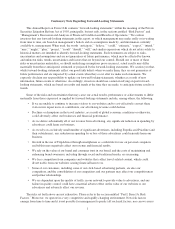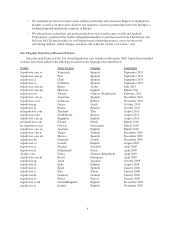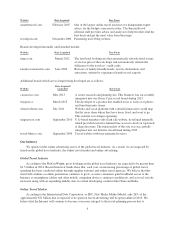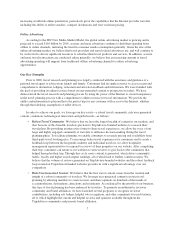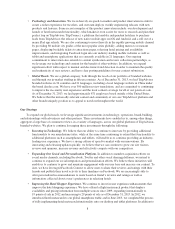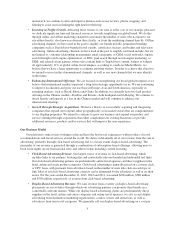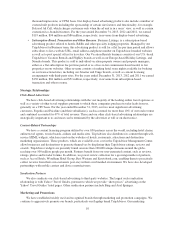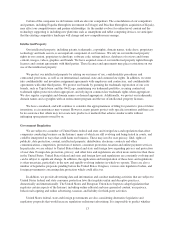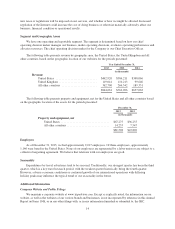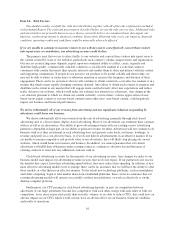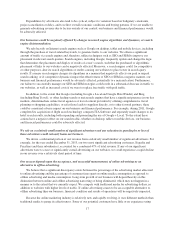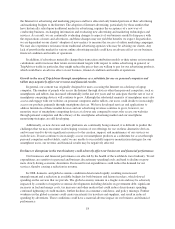TripAdvisor 2013 Annual Report Download - page 21
Download and view the complete annual report
Please find page 21 of the 2013 TripAdvisor annual report below. You can navigate through the pages in the report by either clicking on the pages listed below, or by using the keyword search tool below to find specific information within the annual report.programs are intended to build and maintain the value of our brands, promote consumer engagement and
contributions, drive qualified clicks to our partners and strategically position our brands in the market. Our long-
term success depends on our continued ability to maintain and increase the overall number of consumers flowing
through our brand in a cost-effective manner, as well as our ability to attract consumers who will share their own
content from their trips. Our marketing channels include SEM and SEO. We also reach consumers across the web
through our online marketing program, and offline through our more recent offline brand campaigns. We also
utilize CRM in which we send relevant and engaging traveler communications to our members via email. We
have a robust global public relations program that yields placements on a constant basis in major print and online
publications. We continue to look for new ways to build brand awareness and expand new channels, which may
include traditional media and social media channels including Facebook and Twitter to deepen customer
engagement. We syndicate our content so that other sites can feature TripAdvisor branding and content. Lastly,
marketing and product development initiatives are closely tied. We are constantly creating helpful features and
functionality so that our consumers can discover more relevant travel and review content that they want to talk
about and share with their friends.
Operations and Technology
We have assembled a team of highly skilled software engineers, computer scientists, data scientists, network
engineers, and systems engineers whose expertise spans a broad range of technical areas, including a wide
variety of open source operating systems, databases, languages, analytics, networking, scalable web architecture,
operations, and warehousing technologies. We make significant investments in product and feature development,
data management, personalization technologies, scalable infrastructures, networking, data warehousing, and
search engine technologies. The TripAdvisor-branded websites are powered primarily using Java programming
language.
Our systems infrastructure, web and database servers for TripAdvisor-branded websites are housed at two
geographically separate facilities and have multiple communication links as well as continuous monitoring and
engineering support. Each facility is fully self-sufficient and operational with its own hardware, networking,
software, and content, and is structured in an active/passive, fully redundant configuration. Substantially all of
our software components, data, and content are replicated in multiple datacenters and development centers, as
well as being backed up at offsite locations. Our systems are monitored and protected though multiple layers of
security. Several of our individual subsidiaries and businesses, including our subsidiaries in China, have their
own data infrastructure and technology teams.
Widespread adoption of mobile devices such as iPhone, Android-enabled smart phones and tablets such as
the iPad, coupled with the improved web browsing functionality and development of thousands of useful apps
available on these devices, is driving substantial traffic and commerce activity to mobile platforms. We have seen
tremendous growth in the adoption of mobile platforms, as have our advertising partners. Advertising
opportunities may be more limited on mobile devices given their small screen sizes. Further, given the size and
technical limitations of tablets and smartphones, mobile consumers may not be willing to download multiple
apps from multiple travel service providers and instead prefer to use one or a limited number of apps for their
mobile travel activity. As a result, the consumer experience with mobile apps (as well as brand recognition and
loyalty) is becoming increasingly important and we make significant investments in this area.
We believe that mobile bookings present an opportunity for growth and are necessary to maintain and grow
our business as consumers increasingly turn to mobile devices and mobile applications. If we are unable to
continue to rapidly innovate and create new, user-friendly and differentiated mobile offerings and efficiently and
effectively advertise and distribute on these platforms, or if our mobile apps are not downloaded and used by
travel consumers, we could lose market share to existing or new entrants and our future growth and results of
operations could be adversely effected. As a result, we have made significant progress creating mobile offerings
which have received strong reviews, solid download trends and are driving a material and increasing share of our
business. Our smartphone monetization strategies are still developing, as smartphone monetization was less than
11


